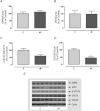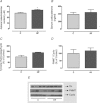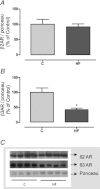Maternal high-fat diet induces obesity and adrenal and thyroid dysfunction in male rat offspring at weaning
- PMID: 22869015
- PMCID: PMC3515834
- DOI: 10.1113/jphysiol.2012.240655
Maternal high-fat diet induces obesity and adrenal and thyroid dysfunction in male rat offspring at weaning
Abstract
Maternal nutritional status affects the future development of offspring. Both undernutrition and overnutrition in critical periods of life (gestation or lactation) may cause several hormonal changes in the pups and programme obesity in the adult offspring. We have shown that hyperleptinaemia during lactation results in central leptin resistance, higher adrenal catecholamine secretion, hyperthyroidism, and higher blood pressure and heart rate in the adult rats. Here, we evaluated the effect of a maternal isocaloric high-fat diet on breast milk composition and its impact on leptinaemia, energy metabolism, and adrenal and thyroid function of the offspring at weaning. We hypothesised that the altered source of fat in the maternal diet even under normal calorie intake would disturb the metabolism of the offspring. Female Wistar rats were fed a normal (9% fat; C group) or high-fat diet (29% fat as lard; HF group) for 8 weeks before mating and during pregnancy and lactation. HF mothers presented increased total body fat content after 8 weeks (+27%, P < 0.05) and a similar fat content at the end of lactation. In consequence, the breast milk from the HF group had higher concentration of protein (+18%, P < 0.05), cholesterol (+52%, P < 0.05) and triglycerides (+86%, P < 0.05). At weaning, HF offspring had increased body weight (+53%, P < 0.05) and adiposity (2 fold, P < 0.05), which was associated with lower β3-adrenoreceptor content in adipose tissue (-40%, P < 0.05). The offspring also presented hyperglycaemia (+30%, P < 0.05) and hyperleptinaemia (+62%, P < 0.05). In the leptin signalling pathway in the hypothalamus, we found lower p-STAT3/STAT3 (-40%, P < 0.05) and SOCS3 (-55%, P < 0.05) content in the arcuate nucleus, suggesting leptin resistance. HF offspring also had higher adrenal catecholamine content (+17%, P < 0.05), liver glycogen content (+50%, P < 0.05) and hyperactivity of the thyroid axis at weaning. Our results suggest that a high fat diet increases maternal body fat and this additional energy is transferred to the offspring during lactation, since at weaning the dams had normal fat and the pups were obese. The higher fat and protein concentrations in the breast milk seemed to induce early overnutrition in the HF offspring. In addition to storing energy as fat, the HF offspring had a larger reserve of glycogen and hyperglycaemia that may have resulted from increased gluconeogenesis. Hyperleptinaemia may stimulate both adrenal medullary and thyroid function, which may contribute to the development of cardiovascular diseases. These early changes induced by the maternal high-fat diet may contribute to development of metabolic syndrome.
Figures










Comment in
-
Maternal high fat diet programming of the endocrine system.J Physiol. 2012 Nov 1;590(21):5267-8. doi: 10.1113/jphysiol.2012.242453. J Physiol. 2012. PMID: 23118065 Free PMC article. No abstract available.
References
-
- Attig L, Solomon G, Ferezou J, Abdennebi-Najar L, Taouis M, Gertler A, Djiane J. Early postnatal leptin blockage leads to a long-term leptin resistance and susceptibility to diet-induced obesity in rats. Int J Obes (Lond) 2008;32:1153–1160. - PubMed
-
- Barker DJ, Eriksson JG, Forsen T, Osmond C. Fetal origins of adult disease: strength of effects and biological basis. Int J Epidemiol. 2002;31:1235–1239. - PubMed
-
- Bjorbaek C, Elmquist JK, Frantz JD, Shoelson SE, Flier JS. Identification of SOCS-3 as a potential mediator of central leptin resistance. Mol Cell. 1998;1:619–625. - PubMed
-
- Bjorbaek C, Kahn BB. Leptin signaling in the central nervous system and the periphery. Recent Prog Horm Res. 2004;59:305–331. - PubMed
Publication types
MeSH terms
Substances
LinkOut - more resources
Full Text Sources
Medical
Research Materials
Miscellaneous

